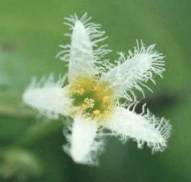Nymphoides thunbergiana
Nymphoides thunbergiana (Griseb.) Kuntze
Family: Menyanthaceae
Common names: floating hearts (Eng.), geelwaterlelie (Afr.), marombodane (Venda)
Introduction
This is a pretty, fast-growing, perennial water plant with flat, rounded, floating leaves, and delicate white and yellow flowers in summer. It makes a useful addition to ornamental ponds and dams, especially for gardeners who may be searching for indigenous alternatives to exotic (and now often outlawed) water plants.

Description
Description
The mother plant has a short, thick stem which is rooted in the mud at the bottom of the pond. New plants are formed all the time where the floating stolons (above-ground, modified stems) form tufted plantlets along their lengths.

Nymphoides thunbergiana has white flowers with yellow centres. The petals have unusual, feathery edges. The flowers are formed above the floating leaves with 20-40 mm long stalks from about October until May.
Conservation Status
Status
Nymphoides thunbergiana is not endangered.
Distribution and habitat
Distribution description
Nymphoides thunbergiana is found in southern Africa and Madagascar. It occurs in pools, pans, marshes and rivers throughout southern Africa.
Derivation of name and historical aspects
History
The genus Nymphoides occurs throughout the world with about eleven species occurring in sub-Saharan Africa. It was previously known as Limnanthemum. The generic name of this plant means 'like Nymphaea', the genus of the water lily which it resembles. The specific name thunbergiana honours Carl Pehr Thunberg (1743-1828), pupil of Linnaeus, collector at the Cape and author of Flora Capensis.
This species was previously included in a broader description of Nymphoides indica, and has now been split into N. thunbergiana and N. brevipedicellata, which occurs in Botswana and Nambia.
It gets its common name, of floating hearts because of the heart-shaped, bright green leaves which lie on the water surface like those of water lilies (Nymphaea species). Although they bear some resemblance to water lilies, they are not related.
There appears to be some confusion about the botanical names of this group of plants particularly regarding flower colour.
Ecology
Ecology
In its natural habitat the plant may be subject to periods where the water may dry up, in this case it forms roots at the nodes to help it survive.
Growing Nymphoides thunbergiana
Grow
Nymphoides thunbergiana may be planted in the soil at the bottom of a pond in about 30-40 cm of water, although it is fairly tolerant of fluctuating water levels. This plant will naturally spread on its own. However, one can also divide it by cutting the stolons between the tufts and removing the plantlets to the new pond or allowing them to root in soil if not already rooted.
Propagation can also be done by seed, although division is by far the easiest method.
The plants may need thinning out from time to time as they can eventually cover the pond.
It looks best in a pond where it is in combination with true water lilies and perhaps a spike-leaved accent plant.
References
- Heywood, V.H. 1978. Flowering plants of the World. Oxford University Press, London.
- Joffe, P. 1993. The gardener's guide to South African plants. Tafelberg, Cape Town.
- Mackinder, B. 1990. Flora zambeziaca 7:4: 51-56pp.
- Pienaar, K. 1991. Gardening with indigenous plants. Struik, Timmins, Cape Town.
- Pooley, E. 1998. A field guide to wild flowers of KwaZulu-Natal and the eastern region. Natal Flora Publications Trust, Durban.
- Klopper, R.R., Chatelain, C. et al. 2006. Checklist of Flowering Plants of Sub-Saharan Africa. Southern African Botanical Diversity Network Report No. 42. SABONET. Pretoria.
Credits
Alice Aubrey and Mhlonishwa D Dlamini
Walter Sisulu National Botanical Garden
September 2003
(Name updated August 2008)
Plant Attributes:
Plant Type: Aquatic
SA Distribution: Eastern Cape, Gauteng, KwaZulu-Natal, Limpopo, Mpumalanga, North West, Western Cape
Soil type:
Flowering season: Early Summer, Late Summer
PH:
Flower colour: Yellow
Aspect: Full Sun
Gardening skill: Easy
Special Features:
Horticultural zones











Rate this article
Article well written and informative
Rate this plant
Is this an interesting plant?
Login to add your Comment
Back to topNot registered yet? Click here to register.